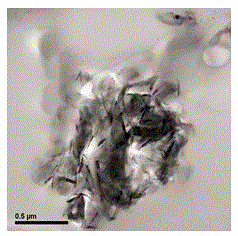A kind of graphene/vinyl chloride in-situ polymerization method
An in-situ polymerization, graphene technology, applied in the field of nanomaterials, can solve the problems of inability to achieve monolayer, nanoscale dispersion, demulsification, difficult to implement, etc., achieve thermodynamic stability, ensure dispersibility, and disperse particle size. small effect
- Summary
- Abstract
- Description
- Claims
- Application Information
AI Technical Summary
Problems solved by technology
Method used
Image
Examples
Embodiment 1
[0031] A kind of graphene / vinyl chloride in-situ polymerization method specifically comprises the following steps:
[0032]Step 1: Add 400mL deionized water to the flask; add 3g of intercalation agent sodium lauryl sulfate, fully dissolve; add 5g of graphene, stir and disperse for 15 minutes; put it into an ultrasonic processor for 15 minutes, and the ultrasonic power is 500 watts; Raise the temperature to 70°C, add 2.4 g of n-hexadecyl alcohol as an emulsifying micelle protective agent; add 200 mL of a 2% aqueous solution of hydroxypropyl methylcellulose ether, and stir thoroughly; put it into an ultrasonic processor for processing, with an ultrasonic power of 500 watts, and The time is 60 minutes.
[0033] Step 2: In situ polymerization of graphene / vinyl chloride. In a 20L stainless steel reaction kettle, add 10kg of deionized water; start stirring, add polyvinyl alcohol as a dispersant, and ammonium bicarbonate as a pH buffer; then add 600mL of the aforementioned in-situ p...
Embodiment 2
[0036] A kind of graphene / vinyl chloride in-situ polymerization method specifically comprises the following steps:
[0037] Step 1: Add 400mL deionized water to the flask; add 5g of sodium dodecylbenzenesulfonate as an intercalation agent, and fully dissolve; add 10g of graphene, stir and disperse for 15 minutes; put it into an ultrasonic processor for 30 minutes, and the ultrasonic power is 1000 Watts; heat up to 70°C, add 10g of n-stearyl alcohol, an emulsifying micellar protective agent; add 200mL of hydroxypropyl methylcellulose ether aqueous solution with a concentration of 2%, and stir thoroughly; put it into an ultrasonic processor for processing, and the ultrasonic power is 1000 watts, Processing time 120 minutes.
[0038] Step 2: In situ polymerization of graphene / vinyl chloride. In a 20L stainless steel reaction kettle, add 10 kg of deionized water; start stirring, add dispersant hydroxypropyl methylcellulose, pH buffer agent ammonia water; add the aforementioned in...
Embodiment 3
[0041] A kind of graphene / vinyl chloride in-situ polymerization method specifically comprises the following steps:
[0042] Step 1: Add 400mL deionized water to the flask; add 5g of sodium dodecyl sulfate and 5g of sodium dodecylbenzenesulfonate as intercalation agents, and fully dissolve; add 50g of graphene, stir and disperse for 15 minutes; put into ultrasonic treatment 15 minutes, ultrasonic power 2000 watts; heat up to 70 ° C, add emulsified micelles protective agent n-heptadecanol 30g, concentration of 2% hydroxypropyl methylcellulose ether aqueous solution 200mL, fully stir; put into ultrasonic processor For processing, the ultrasonic power is 2000 watts, and the processing time is 60 minutes.
[0043] Step 2: In situ polymerization of graphene / vinyl chloride. In a 20L stainless steel reaction kettle, add 10kg of deionized water; start stirring, add polyvinyl alcohol as a dispersant, and ammonium bicarbonate as a pH buffer; then add 600mL of the aforementioned in-situ ...
PUM
 Login to View More
Login to View More Abstract
Description
Claims
Application Information
 Login to View More
Login to View More - R&D
- Intellectual Property
- Life Sciences
- Materials
- Tech Scout
- Unparalleled Data Quality
- Higher Quality Content
- 60% Fewer Hallucinations
Browse by: Latest US Patents, China's latest patents, Technical Efficacy Thesaurus, Application Domain, Technology Topic, Popular Technical Reports.
© 2025 PatSnap. All rights reserved.Legal|Privacy policy|Modern Slavery Act Transparency Statement|Sitemap|About US| Contact US: help@patsnap.com


